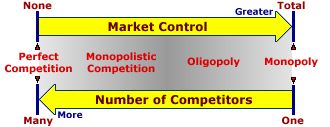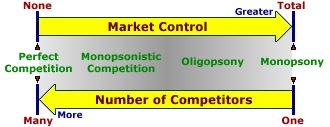MARKET STRUCTURES:
The manner in which markets or industries are organized, based largely on the number of participants in the market or industry and the extent of market control of each participant. Perfect competition represents the benchmark market structure that contains a large number of participants on both sides of the market, and no market control by any firm. Three market structure models with varying degrees of market control on the supply side of the market are: monopoly, monopolistic competition, and oligopoly. Three lesser known market structures with varying degrees of market control on the demand side of the market are: monopsony, oligopsony, and monopsonistic competition.The structure of a market primarily depends on the number of firms operating in the market. Perfect competition is the theoretical benchmark of efficiency achieved because the large number of participants in the market give neither buyers nor sellers market control. Other market structures have different amounts of market control due to different numbers of competitors. In general, more competition means less market control.
Perfect Competition: The Benchmark
Perfect competition is an ideal market structure characterized by a large number of participants on both sides of the market. The product sold by each firm in the market is identical to that sold by every other firm. Buyers and sellers have complete freedom of entry into and exit out of the industry, and perfect knowledge of prices and technology. Perfect competition is an idealized market structure that is not observed in its purest form in the real world. While unrealistic, its primary function is to provide a benchmark that can be used to analyze real world market structures.
In particular, perfect competition efficiently allocates resources. It does this by exchanging the quantity of goods that equate price and marginal cost. With a large number of participants, both buyers and sellers are price takers. Individual participants must exchange goods at the market price and none can influence the market in any way. For this reason, thedemand price buyers are willing to pay, based on the satisfaction received, is equal to the supply price that sellers are willing to accept, based on the opportunity cost of production.
Selling-Side Market Structures
| Market Structure Continuum |
|---|
 |
At the far left is perfect competition. At the far right of the continuum is monopoly. Monopolistic competition resides in the middle of the continuum close to perfect competition. Oligopoly is also in the middle of the continuum close to monopoly.
- Monopoly: To the far right of the market structure continuum is monopoly, characterized by a single competitor and complete control of the supply side of the market. Monopoly contains a single seller of a unique product with no close substitutes. The demand for monopoly output is THE market demand. Monopoly is the worst case scenario of inefficiency on the selling side of the market and thus is often subject to government regulation.
- Monopolistic Competition: In the middle of the market structure continuum, residing closer to perfect competition, is monopolistic competition, characterized by a large number of relatively small competitors, each with a modest degree of market control on the supply side. A key feature of monopolistic competition is product differentiation. The output of each producer is a close but not identical substitute to that of every other firm, which helps satisfy diverse consumer wants and needs. While market control always means inefficiency, monopolistic competition is not a serious offender.
- Oligopoly: Also in the middle of the market structure continuum, but residing closer to monopoly, is oligopoly, characterized by a small number of relatively large competitors, each with substantial market control. Oligopoly sellers exhibit interdependent decision making which can lead to intense competition and the motivation to cooperate through mergers and collusion. Oligopoly tends to have serious inefficiency problems, but also provides the benefits ofinnovation and large scale production.
Buying-Side Market Structures
| Market Structure Continuum |
|---|
 |
At the far left is perfect competition. At the far right of the continuum is monopsony. Monopsonistic competition resides in the middle of the continuum close to perfect competition. Oligopsony is also in the middle of the continuum close to monopsony.
- Monopsony: To the far right of the market structure continuum is monopsony, characterized by a single competitor and complete control of the demand side of the market. Monopsony contains a single buyer in the market and represents the demand-side counterpart to monopoly on the supply side. The supply facing a monopsony is THE market supply. Monopsony is the worst case scenario of inefficiency on the buying side of the market.
- Monopsonistic Competition: In the middle of the market structure continuum, residing closer to perfect competition, is monopsonistic competition, characterized by a large number of relatively small competitors, each with a modest degree of market control on the demand side. Monopsonistic competition represents the demand-side counterpart to monopolistic competition on the supply side. A key feature of monopsonistic competition is product differentiation as each buyer seeks to purchase a slightly different product. While market control always means inefficiency, monopsonistic competition is not a serious offender. Monopsonistically competitive buyers are often on the other side of a market containing monopolistically competitive sellers.
- Oligopsony: Also in the middle of the market structure continuum, but residing closer to monopsony, is oligopsony, characterized by a small number of relatively large competitors, each with substantial market control. Oligopsony represents the demand-side counterpart to Oligopoly on the supply side. Oligopsony buyers, like their oligopoly counterparts, exhibit interdependent decision making which can lead to intense competition and the motivation to cooperate. Oligopsony tends to have serious inefficiency problems. Large firms that operate as oligopoly sellers of the output produced often act as oligopsony buyers of the inputs used.
Two Other Market Structures
Two other market structures that tend to pop up in the analysis of product and factor markets are duopoly and bilateral monopoly.- Duopoly: This is a special type of oligopoly that contains two firms. While the duopoly market structure can and does exist in the real world, it is perhaps most important as a tool used to analyze oligopoly. In is easier to identify the key aspects of collusion, game theory, or other oligopoly behavior using the two-firm duopoly market structure, than a model with more than two firms.
- Bilateral Monopoly: This is a market containing one seller and one buyer. In effect, it is the merger of monopoly from the selling side with monopsony from the buying side. This market structure provides a great deal of insight into unionized labor markets, where the employer is the single monopsony buyer and the labor union represents the monopoly seller.
Other combinations are also possible, such as a market with one seller and two buyers (bilateral monopoly-duopsony?) or a market with a small number of sellers and one buyer (bilateral oligopoly-monopsony?). Some of these alternatives undoubtedly exist in the real world, others might not. However, each variation depends first on a understanding of the basic market structures--perfect competition, monopoly, monopsony, oligopoly, bilateral monopoly, etc.

No comments:
Post a Comment